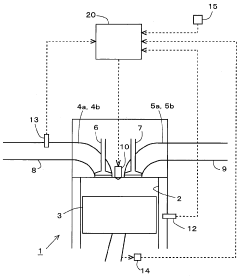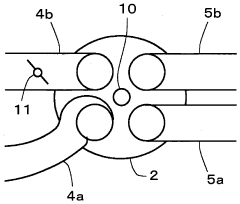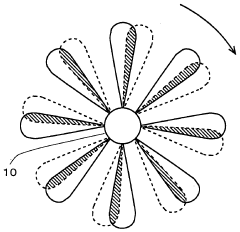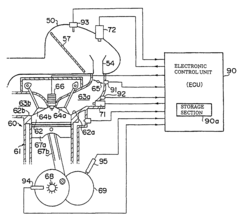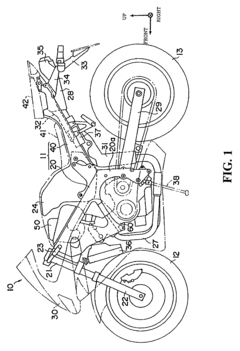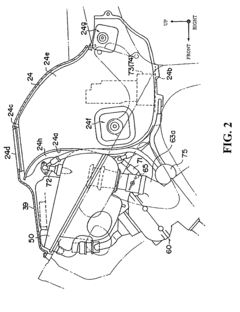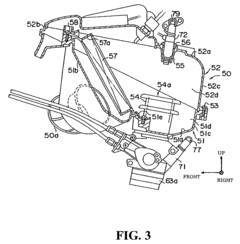Fuel Injection Systems in V8 Engines: How They Work
JUL 4, 20259 MIN READ
Generate Your Research Report Instantly with AI Agent
Patsnap Eureka helps you evaluate technical feasibility & market potential.
V8 Fuel Injection Evolution
The evolution of fuel injection systems in V8 engines represents a significant technological advancement in automotive engineering. The journey began in the 1950s with the introduction of mechanical fuel injection systems, which offered improved performance and fuel efficiency compared to carburetors. These early systems, while innovative, were complex and often unreliable.
The 1960s and 1970s saw the development of electronic fuel injection (EFI) systems, marking a crucial turning point. These systems utilized electronic control units (ECUs) to precisely manage fuel delivery, resulting in better engine performance, reduced emissions, and improved fuel economy. The adoption of EFI in V8 engines was gradual, with luxury and high-performance vehicles leading the way.
By the 1980s, EFI systems became more widespread in V8 engines, driven by stricter emission regulations and demands for better fuel efficiency. This period saw the introduction of multi-point fuel injection (MPFI) systems, which featured individual injectors for each cylinder, allowing for more precise fuel delivery and improved engine response.
The 1990s brought further refinements to EFI systems in V8 engines. Sequential fuel injection became common, where injectors were fired in a specific sequence timed with the engine's firing order. This technology enhanced fuel atomization and distribution, leading to more efficient combustion and reduced emissions.
The turn of the millennium saw the advent of direct fuel injection (DFI) in V8 engines. This technology injects fuel directly into the combustion chamber, rather than the intake port, allowing for higher compression ratios and improved thermal efficiency. DFI systems enabled V8 engines to achieve better power output while meeting increasingly stringent emission standards.
In recent years, the focus has shifted towards combining DFI with other advanced technologies. Variable valve timing, turbocharging, and cylinder deactivation have been integrated with modern fuel injection systems to further optimize V8 engine performance and efficiency. These advancements have allowed V8 engines to remain competitive in an era of increasing environmental concerns and fuel economy requirements.
The latest developments in V8 fuel injection systems include high-pressure DFI systems, capable of operating at pressures exceeding 200 bar, and the integration of artificial intelligence and machine learning algorithms for real-time optimization of fuel delivery based on driving conditions and engine load.
The 1960s and 1970s saw the development of electronic fuel injection (EFI) systems, marking a crucial turning point. These systems utilized electronic control units (ECUs) to precisely manage fuel delivery, resulting in better engine performance, reduced emissions, and improved fuel economy. The adoption of EFI in V8 engines was gradual, with luxury and high-performance vehicles leading the way.
By the 1980s, EFI systems became more widespread in V8 engines, driven by stricter emission regulations and demands for better fuel efficiency. This period saw the introduction of multi-point fuel injection (MPFI) systems, which featured individual injectors for each cylinder, allowing for more precise fuel delivery and improved engine response.
The 1990s brought further refinements to EFI systems in V8 engines. Sequential fuel injection became common, where injectors were fired in a specific sequence timed with the engine's firing order. This technology enhanced fuel atomization and distribution, leading to more efficient combustion and reduced emissions.
The turn of the millennium saw the advent of direct fuel injection (DFI) in V8 engines. This technology injects fuel directly into the combustion chamber, rather than the intake port, allowing for higher compression ratios and improved thermal efficiency. DFI systems enabled V8 engines to achieve better power output while meeting increasingly stringent emission standards.
In recent years, the focus has shifted towards combining DFI with other advanced technologies. Variable valve timing, turbocharging, and cylinder deactivation have been integrated with modern fuel injection systems to further optimize V8 engine performance and efficiency. These advancements have allowed V8 engines to remain competitive in an era of increasing environmental concerns and fuel economy requirements.
The latest developments in V8 fuel injection systems include high-pressure DFI systems, capable of operating at pressures exceeding 200 bar, and the integration of artificial intelligence and machine learning algorithms for real-time optimization of fuel delivery based on driving conditions and engine load.
Market Demand Analysis
The market demand for fuel injection systems in V8 engines has been steadily growing, driven by several key factors. Firstly, the automotive industry's shift towards more efficient and environmentally friendly vehicles has created a strong demand for advanced fuel injection technologies. V8 engines, known for their power and performance, are particularly benefiting from these advancements to meet stringent emissions regulations while maintaining their characteristic performance.
In the luxury and high-performance vehicle segments, where V8 engines are commonly found, there is a growing demand for sophisticated fuel injection systems that can deliver precise fuel metering and optimal combustion. This demand is further amplified by the increasing popularity of sports utility vehicles (SUVs) and performance trucks, many of which utilize V8 engines.
The aftermarket sector also contributes significantly to the market demand. Enthusiasts and performance-oriented consumers are increasingly seeking upgrades to their V8 engines, with fuel injection systems being a popular choice for improving power output, fuel efficiency, and overall engine performance.
Geographically, North America and Europe remain the largest markets for V8 engine fuel injection systems, primarily due to the high concentration of luxury and performance vehicle manufacturers in these regions. However, emerging markets in Asia-Pacific and the Middle East are showing rapid growth, driven by rising disposable incomes and an increasing appetite for high-performance vehicles.
The commercial vehicle sector, particularly in heavy-duty trucks and construction equipment, also contributes to the market demand for V8 engine fuel injection systems. These applications require robust and efficient fuel delivery systems to meet the demanding operational requirements of commercial use.
Looking at industry trends, there is a growing focus on developing fuel injection systems that can support alternative fuels, such as ethanol blends and synthetic fuels, in V8 engines. This trend is in response to the global push for renewable energy sources and the automotive industry's efforts to reduce its carbon footprint.
Furthermore, the integration of advanced electronic control units (ECUs) and sensors with fuel injection systems is becoming increasingly important. This integration allows for real-time adjustments to fuel delivery based on various engine parameters, driving conditions, and environmental factors, resulting in optimized performance and efficiency.
In conclusion, the market demand for fuel injection systems in V8 engines remains robust, driven by a combination of regulatory pressures, consumer preferences, and technological advancements. As the automotive industry continues to evolve, the demand for innovative and efficient fuel injection solutions for V8 engines is expected to persist, with a focus on balancing performance, efficiency, and environmental considerations.
In the luxury and high-performance vehicle segments, where V8 engines are commonly found, there is a growing demand for sophisticated fuel injection systems that can deliver precise fuel metering and optimal combustion. This demand is further amplified by the increasing popularity of sports utility vehicles (SUVs) and performance trucks, many of which utilize V8 engines.
The aftermarket sector also contributes significantly to the market demand. Enthusiasts and performance-oriented consumers are increasingly seeking upgrades to their V8 engines, with fuel injection systems being a popular choice for improving power output, fuel efficiency, and overall engine performance.
Geographically, North America and Europe remain the largest markets for V8 engine fuel injection systems, primarily due to the high concentration of luxury and performance vehicle manufacturers in these regions. However, emerging markets in Asia-Pacific and the Middle East are showing rapid growth, driven by rising disposable incomes and an increasing appetite for high-performance vehicles.
The commercial vehicle sector, particularly in heavy-duty trucks and construction equipment, also contributes to the market demand for V8 engine fuel injection systems. These applications require robust and efficient fuel delivery systems to meet the demanding operational requirements of commercial use.
Looking at industry trends, there is a growing focus on developing fuel injection systems that can support alternative fuels, such as ethanol blends and synthetic fuels, in V8 engines. This trend is in response to the global push for renewable energy sources and the automotive industry's efforts to reduce its carbon footprint.
Furthermore, the integration of advanced electronic control units (ECUs) and sensors with fuel injection systems is becoming increasingly important. This integration allows for real-time adjustments to fuel delivery based on various engine parameters, driving conditions, and environmental factors, resulting in optimized performance and efficiency.
In conclusion, the market demand for fuel injection systems in V8 engines remains robust, driven by a combination of regulatory pressures, consumer preferences, and technological advancements. As the automotive industry continues to evolve, the demand for innovative and efficient fuel injection solutions for V8 engines is expected to persist, with a focus on balancing performance, efficiency, and environmental considerations.
Current Challenges
Fuel injection systems in V8 engines face several significant challenges in the current technological landscape. One of the primary issues is the need for improved fuel efficiency without compromising engine performance. As environmental regulations become increasingly stringent, manufacturers are under pressure to develop injection systems that can deliver precise fuel metering across a wide range of operating conditions.
Another challenge lies in the complexity of modern fuel injection systems. With the integration of advanced electronic controls and multiple injectors per cylinder, these systems require sophisticated algorithms and sensors to function optimally. This complexity not only increases production costs but also poses challenges in terms of reliability and maintenance.
The demand for higher power output and lower emissions simultaneously presents a significant technical hurdle. Engineers must balance these conflicting requirements, often leading to trade-offs in design and performance. Additionally, the pursuit of reduced emissions has led to the development of direct injection systems, which, while effective, introduce new challenges such as increased particulate matter emissions and potential carbon buildup on intake valves.
Fuel quality variations across different markets pose another challenge for fuel injection systems in V8 engines. Designers must create systems that can adapt to various fuel compositions and octane ratings without compromising performance or reliability. This adaptability is crucial for global manufacturers operating in diverse markets with varying fuel standards.
The trend towards engine downsizing and turbocharging also impacts fuel injection system design. V8 engines equipped with turbochargers require injection systems capable of handling higher fuel pressures and temperatures, as well as more precise injection timing to prevent pre-ignition and knock.
Durability and longevity of fuel injection components remain ongoing challenges, particularly in high-performance V8 engines. The extreme pressures and temperatures these systems operate under can lead to wear and degradation over time, necessitating advancements in materials science and engineering to develop more robust components.
Lastly, the integration of alternative fuels, such as ethanol blends or hydrogen, presents new challenges for fuel injection systems. Adapting V8 engines to accommodate these fuels often requires significant modifications to the injection system, including changes to materials, injection pressures, and control strategies. As the automotive industry moves towards more sustainable solutions, addressing these challenges becomes increasingly important for the future of V8 engine technology.
Another challenge lies in the complexity of modern fuel injection systems. With the integration of advanced electronic controls and multiple injectors per cylinder, these systems require sophisticated algorithms and sensors to function optimally. This complexity not only increases production costs but also poses challenges in terms of reliability and maintenance.
The demand for higher power output and lower emissions simultaneously presents a significant technical hurdle. Engineers must balance these conflicting requirements, often leading to trade-offs in design and performance. Additionally, the pursuit of reduced emissions has led to the development of direct injection systems, which, while effective, introduce new challenges such as increased particulate matter emissions and potential carbon buildup on intake valves.
Fuel quality variations across different markets pose another challenge for fuel injection systems in V8 engines. Designers must create systems that can adapt to various fuel compositions and octane ratings without compromising performance or reliability. This adaptability is crucial for global manufacturers operating in diverse markets with varying fuel standards.
The trend towards engine downsizing and turbocharging also impacts fuel injection system design. V8 engines equipped with turbochargers require injection systems capable of handling higher fuel pressures and temperatures, as well as more precise injection timing to prevent pre-ignition and knock.
Durability and longevity of fuel injection components remain ongoing challenges, particularly in high-performance V8 engines. The extreme pressures and temperatures these systems operate under can lead to wear and degradation over time, necessitating advancements in materials science and engineering to develop more robust components.
Lastly, the integration of alternative fuels, such as ethanol blends or hydrogen, presents new challenges for fuel injection systems. Adapting V8 engines to accommodate these fuels often requires significant modifications to the injection system, including changes to materials, injection pressures, and control strategies. As the automotive industry moves towards more sustainable solutions, addressing these challenges becomes increasingly important for the future of V8 engine technology.
Modern Injection Systems
01 Direct fuel injection systems
Direct fuel injection systems involve injecting fuel directly into the combustion chamber of an internal combustion engine. This technology allows for more precise control of fuel delivery, resulting in improved fuel efficiency, reduced emissions, and enhanced engine performance. These systems typically use high-pressure fuel pumps and electronically controlled injectors to deliver fuel at the optimal time and quantity.- Direct fuel injection systems: Direct fuel injection systems involve injecting fuel directly into the combustion chamber of an internal combustion engine. This technology allows for more precise control over fuel delivery, resulting in improved fuel efficiency, reduced emissions, and enhanced engine performance. These systems typically use high-pressure fuel pumps and electronically controlled injectors to deliver fuel at the optimal time and quantity.
- Electronic control units for fuel injection: Electronic control units (ECUs) play a crucial role in modern fuel injection systems. These computerized modules use various sensors to monitor engine conditions and adjust fuel delivery in real-time. ECUs can optimize fuel injection timing, duration, and quantity based on factors such as engine speed, load, temperature, and air intake. This results in improved engine performance, fuel economy, and emissions control across a wide range of operating conditions.
- Common rail fuel injection systems: Common rail fuel injection systems use a high-pressure fuel rail to supply fuel to individual injectors. This design allows for multiple injection events per combustion cycle and maintains consistent fuel pressure across all cylinders. Common rail systems offer benefits such as reduced engine noise, improved fuel atomization, and the ability to precisely control injection timing and quantity, leading to better performance and lower emissions in diesel engines.
- Fuel injector designs and improvements: Advancements in fuel injector design focus on improving fuel atomization, spray patterns, and durability. Modern injectors may incorporate features such as multiple nozzle holes, piezoelectric actuators, or ball-valve designs to enhance fuel delivery precision and efficiency. These improvements contribute to better fuel-air mixing, more complete combustion, and reduced emissions across various engine types and operating conditions.
- Alternative fuel injection systems: Alternative fuel injection systems are designed to accommodate non-traditional fuels such as natural gas, hydrogen, or biofuels. These systems may require specialized injectors, fuel rails, and control strategies to handle the unique properties of alternative fuels. Developments in this area aim to improve the flexibility of engines to operate on multiple fuel types, reduce dependence on fossil fuels, and lower overall emissions while maintaining performance and reliability.
02 Electronic control units for fuel injection
Electronic control units (ECUs) play a crucial role in modern fuel injection systems. These computerized modules manage various aspects of fuel injection, including timing, duration, and quantity of fuel delivery. ECUs use input from multiple sensors to optimize engine performance, fuel efficiency, and emissions control in real-time. They can also adapt to different driving conditions and engine loads.Expand Specific Solutions03 High-pressure fuel injection systems
High-pressure fuel injection systems operate at significantly higher pressures than traditional systems, allowing for better fuel atomization and more efficient combustion. These systems can achieve pressures of several thousand bar, resulting in improved fuel economy, reduced emissions, and increased power output. Common rail diesel injection systems are a notable example of this technology.Expand Specific Solutions04 Multi-point fuel injection systems
Multi-point fuel injection systems feature individual injectors for each cylinder, typically located near the intake valve. This design allows for more precise fuel distribution compared to single-point injection systems. Multi-point injection improves fuel efficiency, reduces emissions, and enhances engine performance by ensuring each cylinder receives the optimal amount of fuel.Expand Specific Solutions05 Alternative fuel injection systems
Alternative fuel injection systems are designed to work with non-traditional fuels such as natural gas, propane, or hydrogen. These systems require specialized injectors, fuel rails, and control strategies to accommodate the unique properties of alternative fuels. They play a crucial role in reducing dependence on conventional fossil fuels and lowering emissions in various applications, including automotive and industrial sectors.Expand Specific Solutions
Key Industry Players
The fuel injection systems market for V8 engines is in a mature stage, with established players dominating the landscape. The market size is substantial, driven by the continued popularity of V8 engines in high-performance vehicles and heavy-duty applications. Technologically, fuel injection systems have reached a high level of sophistication, with companies like Robert Bosch GmbH, Denso Corp., and Continental Automotive GmbH leading innovation. These firms, along with major automotive manufacturers such as Toyota Motor Corp. and Honda Motor Co., Ltd., are continuously refining their systems to improve efficiency and meet stringent emissions standards. The competition is intense, with a focus on developing more precise, electronically controlled injection systems that optimize fuel delivery and engine performance.
Robert Bosch GmbH
Technical Solution: Bosch's fuel injection system for V8 engines employs direct injection technology, utilizing high-pressure fuel pumps capable of delivering fuel at pressures up to 200 bar [1]. The system features piezoelectric injectors that can perform multiple injections per combustion cycle, enhancing fuel atomization and mixture formation [2]. Bosch's engine control unit (ECU) uses advanced algorithms to precisely control injection timing and duration based on real-time engine parameters, ensuring optimal fuel economy and performance [3]. The system also incorporates a dual-circuit cooling system for the injectors, maintaining consistent performance across varying engine temperatures [4].
Strengths: High precision fuel delivery, improved fuel economy, and reduced emissions. Weaknesses: Higher system complexity and cost compared to traditional fuel injection systems.
GM Global Technology Operations LLC
Technical Solution: GM's fuel injection system for V8 engines utilizes direct injection technology with solenoid-actuated injectors capable of multiple injections per cycle [1]. The system operates at pressures up to 150 bar and features a high-pressure fuel pump driven by a dedicated lobe on the camshaft [2]. GM's proprietary engine control software optimizes injection timing and quantity based on various sensor inputs, including mass airflow, throttle position, and oxygen sensors [3]. The system also incorporates a returnless fuel system design, which helps maintain consistent fuel pressure and reduces heat transfer to the fuel [4].
Strengths: Improved fuel efficiency, better cold-start performance, and reduced emissions. Weaknesses: Increased system complexity and potential for carbon buildup on intake valves.
Innovative Fuel Strategies
Fuel injection system for compression ignition type internal combustion engine
PatentWO2008136525A1
Innovation
- A fuel injection system with circumferentially arranged injection holes and a swirl generating mechanism that shortens the interval between sub-fuel injections and the main fuel injection, utilizing swirl to control fuel spray overlap and enhance ignitability by forming a local air-fuel mixture with a relatively low air-fuel ratio.
Fuel injection system for engine
PatentInactiveUS7383811B2
Innovation
- A fuel injection system with upstream and downstream valves, where the upstream valve has a higher injection pressure than the downstream valve, and an electronic control unit adjusts fuel shares based on engine load, ensuring efficient fuel delivery and enhanced combustion efficiency.
Emissions Regulations
Emissions regulations have played a significant role in shaping the development and implementation of fuel injection systems in V8 engines. These regulations, aimed at reducing harmful emissions and improving air quality, have become increasingly stringent over the years, forcing automotive manufacturers to continuously innovate and refine their fuel injection technologies.
The introduction of catalytic converters in the 1970s marked a turning point in emissions control. This technology, combined with early electronic fuel injection systems, allowed for more precise fuel metering and better control over the air-fuel mixture. As a result, V8 engines could maintain power output while significantly reducing emissions of carbon monoxide, hydrocarbons, and nitrogen oxides.
In the 1990s, the implementation of On-Board Diagnostics II (OBD-II) systems further enhanced emissions control capabilities. These systems monitor various engine parameters and emissions-related components, ensuring that fuel injection systems operate within specified parameters to maintain low emissions levels throughout the vehicle's lifetime.
The advent of direct fuel injection technology in the early 2000s represented another major leap forward in emissions reduction for V8 engines. By injecting fuel directly into the combustion chamber at high pressure, direct injection systems allow for more precise fuel control and improved fuel atomization. This results in more complete combustion, reduced fuel consumption, and lower emissions.
Recent years have seen the introduction of even more advanced emissions regulations, such as Euro 6 in Europe and Tier 3 in the United States. These standards have pushed manufacturers to implement sophisticated technologies like selective catalytic reduction (SCR) and gasoline particulate filters (GPF) in conjunction with advanced fuel injection systems.
To meet these stringent requirements, modern V8 engines often employ multi-port fuel injection systems with high-pressure direct injection. This combination allows for optimized fuel delivery across different engine operating conditions, resulting in improved fuel efficiency and reduced emissions. Additionally, variable valve timing and lift systems work in tandem with fuel injection to further optimize combustion and minimize emissions.
The ongoing push for lower emissions has also led to the development of cylinder deactivation technologies in V8 engines. These systems, which temporarily shut down a portion of the engine's cylinders during light load conditions, rely on precise fuel injection control to seamlessly transition between full and partial cylinder operation, further reducing fuel consumption and emissions.
As emissions regulations continue to evolve, fuel injection systems in V8 engines will likely see further advancements. Future technologies may include even higher-pressure direct injection systems, more sophisticated engine control units, and integration with hybrid powertrains to meet increasingly stringent emissions targets while maintaining the performance characteristics that V8 engines are known for.
The introduction of catalytic converters in the 1970s marked a turning point in emissions control. This technology, combined with early electronic fuel injection systems, allowed for more precise fuel metering and better control over the air-fuel mixture. As a result, V8 engines could maintain power output while significantly reducing emissions of carbon monoxide, hydrocarbons, and nitrogen oxides.
In the 1990s, the implementation of On-Board Diagnostics II (OBD-II) systems further enhanced emissions control capabilities. These systems monitor various engine parameters and emissions-related components, ensuring that fuel injection systems operate within specified parameters to maintain low emissions levels throughout the vehicle's lifetime.
The advent of direct fuel injection technology in the early 2000s represented another major leap forward in emissions reduction for V8 engines. By injecting fuel directly into the combustion chamber at high pressure, direct injection systems allow for more precise fuel control and improved fuel atomization. This results in more complete combustion, reduced fuel consumption, and lower emissions.
Recent years have seen the introduction of even more advanced emissions regulations, such as Euro 6 in Europe and Tier 3 in the United States. These standards have pushed manufacturers to implement sophisticated technologies like selective catalytic reduction (SCR) and gasoline particulate filters (GPF) in conjunction with advanced fuel injection systems.
To meet these stringent requirements, modern V8 engines often employ multi-port fuel injection systems with high-pressure direct injection. This combination allows for optimized fuel delivery across different engine operating conditions, resulting in improved fuel efficiency and reduced emissions. Additionally, variable valve timing and lift systems work in tandem with fuel injection to further optimize combustion and minimize emissions.
The ongoing push for lower emissions has also led to the development of cylinder deactivation technologies in V8 engines. These systems, which temporarily shut down a portion of the engine's cylinders during light load conditions, rely on precise fuel injection control to seamlessly transition between full and partial cylinder operation, further reducing fuel consumption and emissions.
As emissions regulations continue to evolve, fuel injection systems in V8 engines will likely see further advancements. Future technologies may include even higher-pressure direct injection systems, more sophisticated engine control units, and integration with hybrid powertrains to meet increasingly stringent emissions targets while maintaining the performance characteristics that V8 engines are known for.
Performance Optimization
Performance optimization in fuel injection systems for V8 engines is a critical aspect of enhancing overall engine efficiency and power output. The primary focus of optimization efforts lies in fine-tuning the fuel delivery process to achieve optimal combustion characteristics across various operating conditions.
One key area of improvement is the precision of fuel metering. Advanced electronic control units (ECUs) utilize complex algorithms to calculate the exact amount of fuel required for each combustion cycle. These calculations take into account multiple parameters such as engine load, throttle position, air temperature, and oxygen sensor feedback. By continuously adjusting fuel delivery based on real-time data, modern fuel injection systems can maintain an ideal air-fuel ratio, resulting in improved fuel economy and reduced emissions.
Injector design plays a crucial role in performance optimization. High-pressure direct injection systems, capable of operating at pressures exceeding 2,000 bar, allow for finer fuel atomization. This leads to more efficient fuel vaporization and mixing with air, promoting complete combustion. Additionally, multi-hole injectors with optimized spray patterns ensure even fuel distribution within the combustion chamber, minimizing wall wetting and reducing the formation of carbon deposits.
Timing optimization is another critical factor in enhancing V8 engine performance. Precise control over injection timing allows for multiple injection events per combustion cycle. Pre-injection can help reduce engine noise and vibration, while post-injection can aid in exhaust aftertreatment processes. The ability to adjust injection timing based on engine speed and load enables engineers to optimize power output across the entire operating range of the engine.
Fuel pressure regulation is essential for maintaining consistent injection characteristics. Variable-pressure fuel pumps, controlled by the ECU, can adjust fuel pressure based on engine demands. This ensures optimal fuel atomization at all engine speeds and loads, contributing to improved throttle response and overall engine efficiency.
Integration of advanced sensors and feedback systems further enhances performance optimization. Wide-band oxygen sensors provide precise measurements of exhaust gas composition, allowing for closed-loop fuel control. Knock sensors enable the ECU to detect and mitigate pre-ignition, allowing for more aggressive ignition timing without risking engine damage.
Lastly, calibration and mapping play a vital role in extracting maximum performance from fuel injection systems. Through extensive dyno testing and real-world validation, engineers can fine-tune injection parameters for specific engine configurations and operating conditions. This process often involves creating detailed three-dimensional maps that define optimal fuel delivery strategies across the entire engine operating envelope.
One key area of improvement is the precision of fuel metering. Advanced electronic control units (ECUs) utilize complex algorithms to calculate the exact amount of fuel required for each combustion cycle. These calculations take into account multiple parameters such as engine load, throttle position, air temperature, and oxygen sensor feedback. By continuously adjusting fuel delivery based on real-time data, modern fuel injection systems can maintain an ideal air-fuel ratio, resulting in improved fuel economy and reduced emissions.
Injector design plays a crucial role in performance optimization. High-pressure direct injection systems, capable of operating at pressures exceeding 2,000 bar, allow for finer fuel atomization. This leads to more efficient fuel vaporization and mixing with air, promoting complete combustion. Additionally, multi-hole injectors with optimized spray patterns ensure even fuel distribution within the combustion chamber, minimizing wall wetting and reducing the formation of carbon deposits.
Timing optimization is another critical factor in enhancing V8 engine performance. Precise control over injection timing allows for multiple injection events per combustion cycle. Pre-injection can help reduce engine noise and vibration, while post-injection can aid in exhaust aftertreatment processes. The ability to adjust injection timing based on engine speed and load enables engineers to optimize power output across the entire operating range of the engine.
Fuel pressure regulation is essential for maintaining consistent injection characteristics. Variable-pressure fuel pumps, controlled by the ECU, can adjust fuel pressure based on engine demands. This ensures optimal fuel atomization at all engine speeds and loads, contributing to improved throttle response and overall engine efficiency.
Integration of advanced sensors and feedback systems further enhances performance optimization. Wide-band oxygen sensors provide precise measurements of exhaust gas composition, allowing for closed-loop fuel control. Knock sensors enable the ECU to detect and mitigate pre-ignition, allowing for more aggressive ignition timing without risking engine damage.
Lastly, calibration and mapping play a vital role in extracting maximum performance from fuel injection systems. Through extensive dyno testing and real-world validation, engineers can fine-tune injection parameters for specific engine configurations and operating conditions. This process often involves creating detailed three-dimensional maps that define optimal fuel delivery strategies across the entire engine operating envelope.
Unlock deeper insights with Patsnap Eureka Quick Research — get a full tech report to explore trends and direct your research. Try now!
Generate Your Research Report Instantly with AI Agent
Supercharge your innovation with Patsnap Eureka AI Agent Platform!
